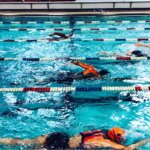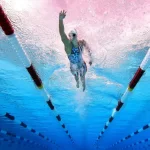When it comes to triathlon training, the swimming portion of your race can be the trickiest part to train for. Unless you have easy access to a safe open water swimming environment, swimming in a pool is your best bet. While you are still able to check off your swim training for the week in a pool, it is important to understand that both physically and mentally, there is a difference between open water swimming and pool swimming. Preparing yourself ahead of race day for these differences is key to a great swim.
What are the main differences between swimming in the open water and swimming in a pool?
1. Controlled vs. Uncontrolled Environment
Training in a pool means swimming in a controlled environment. You have your own lane, away from other people and the water is calm. When it comes time to head into the open water for your triathlon you will not only be surrounded by fellow racers, but you will be diving head first into a chaotic swimming environment. In open water you need to practice sighting as you will be swimming in a much bigger space, whereas in a pool you can follow the black line on the floor. If it’s a cloudy or foggy day outside, visibility can be tough making it harder to see where you’re going.
2. Physical and Mental Reaction to open water
An uncontrolled environment means your body is going to react differently. You must deal with disrupted breathing patterns, thrashing arms and feet from other swimmers, dark water with foggy goggles. It’s important to head into your open water swim knowing these things will happen. If you go into the water expecting the same experience as a pool swim, you could cause yourself to panic, making breathing and navigation even more difficult.
3. Swim Stroke Different with Race Day Gear
Swimming in a wetsuit in the open water is quite different than swimming in a pool with a bathing suit. If you’ve never worn a wetsuit, it’s time to suit up and practice swimming with one. Not only does a wetsuit feel different, but it changes your buoyancy. Whether you choose a wetsuit with or without sleeves, the thickness of the fabric can also change your stroke pattern, making your typical swimming method feel off. As with any aspect of triathlon training, it’s important to wear gear before actually using them in a race. It may seem odd to hop in your local lap pool with a wetsuit on, but it will help you in the long run if you cannot get to the open water to practice.
It’s also important to note that more buoyancy means you’re more likely to get salt water in your mouth so preparing for that strange taste ahead of time is important. The last thing you want to do is choke or gag during your swim when you should be focused on calm and controlled breaths.
Open water presents far more mental and physical challenges to overcome than pool swimming. While the key differences between open water swimming and pool swimming can feel overwhelming, if you head into your race knowing these differences and have practiced overcoming typical open water swimming obstacles such as swimming environment, swimming position, and breathing patterns, you can execute your swim just as you did in your practice runs.
Other helpful blog posts from Tri Right Coaching to prepare you for for open water swimming:
How to Find the Best Wetsuit for You
How to Become More Comfortable in Open Water
Looking for more ways to ensure you’re physically and mentally prepared for your open water swim? Contact me today to set up a free coaching consultation!
Train Right, Tri Right!
Coach MJ







